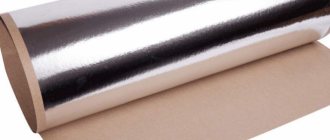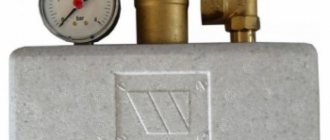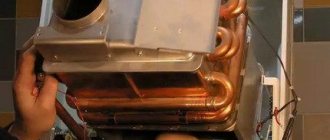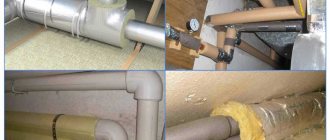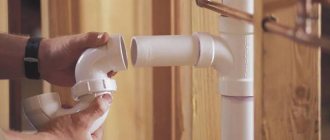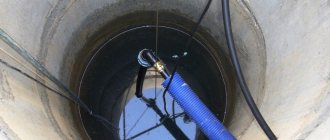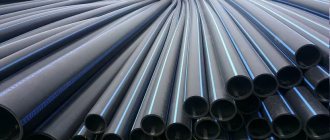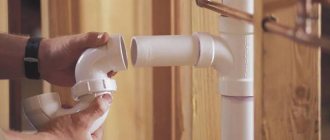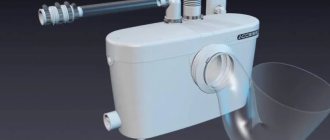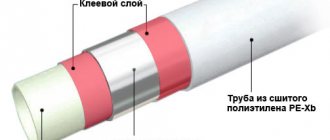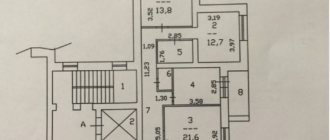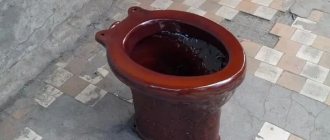The operation of sewer pipelines is influenced by numerous factors, including cold. In order for the system to function normally even at very low temperatures, it is necessary to select the correct insulation for sewer pipes and install it.
Thermal insulation materials are presented on the market in a wide range, and deciding on a purchase is sometimes quite difficult, don’t you agree? We will help you resolve this issue. The article provides an overview of various types of insulation, describes their characteristics, installation features and application.
Rules for choosing insulation
There is a huge selection of insulation materials on the construction market, but not all can be used as insulation for sewer pipes.
The main task of insulation is not to heat the outlet, but to reduce heat exchange between the external environment and the liquid circulating through the pipes.
In order for pipe insulation to effectively perform its main function - heat preservation, it must meet 7 basic requirements:
- have a thermal conductivity coefficient as low as possible;
- retain their properties for a long time;
- withstand large temperature changes;
- have good waterproofing properties;
- be resistant to aggressive environmental influences;
- do not support combustion and do not emit toxic smoke;
- be easy to install.
External sewerage pipes and a main line laid in an unheated room are subject to insulation. The only exceptions are those regions where even in winter it never drops below 0°C.
For others, the only question is the choice of method and material. Insulation materials are chosen based on the reputation of the manufacturer or brand, but the surest way is to focus on the material of manufacture.
To better navigate the variety of insulation products produced, you need to proceed from 3 rules: if several materials are found that satisfy the requirements for them, choose the cheapest, easiest to install, long known on the market and well-proven
Most often, sewer pipes are insulated with mineral wool, expanded clay, styrofoam and polyurethane foam insulation. Liquid insulation also finds its use. All of them are used for passive insulation.
Image gallery
Photo from
Laying an external line without insulation
Insulation of sewerage next to the hot water riser
Insulation of pipes before laying in a trench
Thermal insulation during construction
In addition to them, there are 2 more options for protecting pipes from frost - laying below the freezing level of soil layers and using active insulation. The latter includes cable insulation.
Electrical cable
This is not exactly the kind of cable that we are used to seeing for outdoor work. This is a metal wire without insulation and with increased resistance.
When an electric current passes through it, it converts it into heat energy. So, when laying such a cable underground, along with drainage pipes, it helps to warm them up in winter.
Active heating using heating elements has its own characteristics and positive aspects:
Heating cable device diagram
- protection of open sewage system;
- heating of communications in boxes, tunnels, channels;
- thermal insulation of collectors installed in the ground.
There are two types of heating elements used when laying communications to heat them:
- resistive - regardless of the time of year or external conditions, it constantly warms up. When using this element, the heating system must be constantly monitored;
- self-regulating – does not require constant monitoring, as it is able to independently assess external conditions and adapt to them.
Scheme of sewer insulation with heating cable
Heating cable design option
This method has a significant disadvantage - dependence on the availability of electricity and good voltage in the network; in the event of an accident - which often happens - there is the possibility of defrosting all communication systems during cold weather. Insulation of drainage systems using electrical cables requires the following preparatory measures:
- Select areas for thermal insulation.
- Calculate the amount of material - in this case cable.
- Decide which heating method will be preferable for you, self-regulating or resistive.
Calculation table for pipe insulation
Expanded polystyrene heat insulator for pipes
Foam shells are a popular insulation material for insulating sewer pipes. Two percent of its composition is small, from 1 to 5 mm, polystyrene granules, the remaining 98% is air. After processing the material with a gas-forming agent, the granules become light, elastic, attract each other and stick together.
By pressing followed by high-temperature steam treatment, the material is given the desired shape.
It's basically just foam, but in a shell shape that's designed to last over and over again. The difference between the thermal conductivity coefficient of polystyrene foam insulation (0.03-0.05) and mineral wool is small. The shell, which has the shape of a hemisphere, copes with the task of preserving heat quite effectively.
The foam shell can consist of 2 or 3 elements. On their sides there are locks with a device for fastening. The shell is selected according to the diameter of the pipe and, having been placed on it, is snapped into place.
Since foam plastic is not very resistant to mechanical stress, manufacturers provide shells with an outer coating of aluminum foil, fiberglass and other materials.
High thermal insulation properties are provided by thin-walled microcells that do not allow heat to pass through. The service life of the thermal insulation shell is quite long - about 50 years.
There are 2 types of this material - ordinary and extruded polystyrene foam. The characteristics of the latter are higher, but the cost also differs significantly.
Despite a lot of positive qualities, polystyrene foam also has disadvantages. It does not tolerate ultraviolet radiation, so when laying pipes in open areas, additional protection from the sun is required. This material is dense, but fragile, and when burned it can cause poisoning, because The smoke it produces is poisonous.
Installation work is so simple that it does not require special qualifications. Having placed the insulation segments on the sewer pipe, they overlap, displacing them along the length relative to each other by 200-300 mm. To avoid the appearance of cold bridges, the thermal insulation elements are joined together using a quarter or tongue-and-groove system.
After the connection is made, both parts are strongly compressed. The contact points are taped with tape. Sometimes the joints are coated with glue, but then the insulation loses such an advantage as the possibility of reuse, because When dismantling it will have to be cut.
The shell is covered with a protective covering, which comes with it, or simply wrapped with plastic film if it is not available.
The shell is used both on above-ground routes and for laying highways underground. This insulation can be put on a pipe with a minimum diameter of 1.7 cm and a maximum of 122 cm. Already with a diameter of 200 mm, the cylinder consists of 4 elements, and for large products there can be 8.
Trenches with sewer pipes are first filled with sand to a height of about 0.2 m, then with earth. In regions with very cold winters, thermal insulation in the form of a polystyrene foam shell is supplemented with an insulating cable, placing it under the shell.
Image gallery
Photo from
Polystyrene shell for pipe insulation
Shell made of ordinary foam plastic
Basement use
Expanded polystyrene shell with waterproofing
Thermal insulation for metal products underground
To properly install a metal sewer system, it is necessary to purchase not only high-quality components, but also to ensure the functionality of the system.
Insulation of sewerage in a private house Do-it-yourself sewerage in a private house Vacuum valves
The choice of options in this situation is simply amazing in variety. But, before making a decision, it is recommended to get acquainted with their technical characteristics.
Experts recommend shells as the highest priority thermal insulation option for metal sewers.
This thermal insulation is easy to select for a metal pipeline of any volume. When choosing a shell, craftsmen advise choosing options made from polystyrene foam. Plastic is slightly inferior in that it is susceptible to combustion and can allow a little steam to pass through it.
Shell-type insulation for metal sewer pipes can be produced with additional protection against moisture. And this type of thermal insulation is most suitable for metal sewers laid in the ground.
Polyurethane foam shells
Polyurethane foam cylinders are a good alternative to their foam counterparts. They differ in comparison with their higher density, and the thermal conductivity coefficient is almost the same.
Polyurethane foam also has higher resistance to mechanical stress. It also has a wider temperature range in which it can be operated without loss of strength characteristics.
The normal temperature regime for polyurethane shells is -180⁰ - +130⁰. This material also has a high fire safety indicator - it lights up at 415⁰ and subsequently self-extinguishes
Thermal insulation has the form of half-cylinders equipped with transverse or longitudinal latches. To increase the reliability of protection, the shells are sometimes enclosed in special galvanized casings equipped with locks, but more often they are simply coated with a special coating.
Application of foamed polyethylene
Foamed polyethylene is often used as insulation for sewer pipes. This is not a very dense material - up to 40 kg/mᶾ. The thermal conductivity coefficient is within 0.05.
Does not change its properties when used in the temperature range -50°C - + 90°C. The small thickness of the material allows you to save space, so its use is justified where there is a very small gap between the pipes and the wall.
Foamed polyethylene tolerates well even prolonged exposure to moisture. It is fire resistant. Withstands more than 300⁰. When the material burns, its emissions into the atmosphere do not contain dangerous toxins
The advantage of insulation is lightness, durability, and affordable price. This insulation is produced by such manufacturers as Magniflex and Penofol , Energoflex , Thermoflex . It is produced in the form of cylinders of different diameters and in rolls. There are foil one and two sided options.
This option of thermal insulation in the installation of sewer pipes is rarely used; it is used to insulate communication areas located in basements and above ground.
Laying the pipeline below the frost depth
When laying a sewage system on your own, you can try to lay the parts to a depth that will be 10 centimeters below the soil freezing level. With this arrangement, additional thermal insulation of sewer pipes will not be required. Naturally, this is considered an ideal option, but it is used extremely rarely.
Causes:
- The presence of a large amount of work that will have to be carried out when preparing a trench for laying, as well as for digging a hole for a septic tank. If special equipment is not involved, then it is extremely difficult to make such a volume with your own hands.
- In the middle zone, the depth of soil freezing is one and a half meters. It turns out that the pipes will have to be laid to a depth of 1.6 m. In addition, the pipeline must be laid with a slope, so the septic tank must be laid at a depth of two and a half or three meters. The use of such a drainage system is irrational.
- When sewer pipes are too deep, it will be impossible to repair the drain, especially in winter.
It turns out that the choice of the option of deepening below the soil freezing level can be selected only in the case when it is possible to attract special equipment for the work.
Using foil insulation for pipe insulation
Most often, the material is used for external communications made of metal-plastic pipes. There are 2 types of folgoizol - SRF and FG. In its production, foil is used - corrugated or aluminum and a bitumen-polymer layer for the binder.
It goes on sale in the form of rolls. The material is durable, environmentally friendly, and has a long service life. Has proven itself well in regions with different climates.
Foamed rubber as insulation
This insulating material is made on the basis of natural or combined rubber. It is characterized by high fire safety and elasticity. Pipe insulation using this material is performed by gluing. As a result of the interpenetration of surfaces, a strong seam is obtained.
The structure of foam rubber is closed and porous. Because of this, it has increased flexibility. On the construction market, this thermal insulation is presented in the form of sheets, cylinders, rolls
Thermal insulation is produced by such manufacturers as the Italian company K-FLEX , the German companies ARMAFLEX and KAYFLEX . Due to the high cost, foam rubber is used extremely rarely for insulating sewer pipes.
Products Leroy Marlene
Insulation for external sewer pipes from Leroy Merlin stands out among the line of similar products. The Leroy Merlin chain of stores offers consumers an assortment of excellent quality at very competitive prices.
Technologies do not stand still and the range is constantly growing. Among the product line of this online store, ready-made insulated pipes should be highlighted.
These are products made of plastic and metal, as well as other materials that can be laid in the ground above the freezing level without fear. When making a purchase from Leroy Merlin, you can be sure that the line will operate smoothly at any temperature.
Their cost will be an order of magnitude higher, and many people insulate simple pipes in the ground with cheaper insulation materials.
All other products from Leroy Merlin are of high quality and affordable prices. The most expensive method is considered to be finishing with basalt glass wool.
All provided building materials can be used for all types of pipe rolling. And each of them meets the requirements for this product:
- Fire resistance.
- Waterproof.
- Long service life.
- Easy to install.
- Low cost.
Insulation of the sewer system in the ground
When choosing thermal insulation, you need to take into account the climatic conditions of the region, the depth of the sewer pipe in the ground, as well as financial capabilities.
Insulation of external sewerage can entail significant investment. This is especially true for pipelines that are long.
The insulation of the sewer pipe is carried out using established technology. First of all, the highway is laid in the ground. To do this, a trench is dug, the width of which depends on the diameter of the pipeline, and the depth is not less than 60 cm.
Ditch dimensions may vary. It all depends on the climatic conditions of the region and the diameter of the pipeline itself.
The width of the trench should be sufficient so that it can be easily laid in the ground. Do not forget about the slope, which is 1 cm per meter of length.
The pipeline is assembled on the surface and then laid in a trench. When joining, it is worth using a sealant. It is applied to the edges of the pipe and rubber seal.
With this you can make a reliable and hermetically sealed joining of pipes. After this, the selected insulating material is put on the pipe.
Insulation is a responsible process. Here you need to make sure that the insulating material fits tightly. It must be securely fixed to the sewer pipe.
To do this, experts recommend using tape that wraps thermal insulation material around the entire perimeter. The adhesive tape acts as a guarantee that the insulation will not slide off the line as a result of soil displacement.
Laying the pipeline in the ground
How to properly lay sewer pipes | Sewer slope
After the insulation is fixed, the pipeline is laid in the trench.
At the same time, do not forget about its slope, which will ensure natural waste flow in the right direction.
The slope is created using a sand cushion, which is placed at the bottom of the trench. It is also advisable to use sand to backfill the external pipeline. But for this you can also take previously dug soil. The main thing is that there are no sharp objects in it that could damage the insulation and the sewer system itself.
Then the system is backfilled and compacted. At this stage, the installation of external sewerage can be considered complete. If all work was carried out correctly, the insulation will serve for a long time.
Table of soil freezing by regions of the Russian Federation
It is important to consider that soil freezing rates are different in each climate zone. You can find out what the standards are for a particular region from specially designed maps. They provide accurate data on the depth of soil freezing.
We offer you to download a file where you can find out the level of soil freezing for each region -.
IMPORTANT! This method cannot be used in areas where the freezing depth is more than one meter and where the groundwater level is high.
For example, the level of soil freezing is 1.4 meters, and groundwater is located no deeper than one meter underground. In such conditions, the required level of the cesspool will be constantly filled with water.
But you cannot raise the pipeline close to the surface, otherwise they may freeze. So it turns out that in the current situation it is necessary to look for other, more expensive methods of laying sewer pipes.
Insulating the sewer system at home Is it necessary to insulate sewer pipes in winter?
This method is more suitable for areas with warm climates. In mild winter conditions, the soil does not freeze over a long distance, therefore, trenches for external sewage can not be made very deep.
But, starting from the middle zone areas, deeper trenches will have to be prepared for such highways, and this leads to additional costs for laying communications.
It is also necessary to add here that the pipeline must be laid on a slope, and with each linear meter of the sewerage pipeline, the trenches will have to be deepened. Based on these facts, the conclusion suggests itself is that in cold regions it is more economical to insulate such a system.
Insulation of sewer pipe
ADVICE. In order to maintain a normal temperature in the external sewer line, an inspection well should be installed in the septic tank. It is placed above the lid of the septic tank. This design option creates an additional air “cushion” over the septic tank; it helps maintain positive temperatures at sub-zero temperatures.
As for internal sewerage, it is quite possible to do without insulation, since it operates under the same temperature conditions.
Condensation does not appear on it, like on a cold water supply line. The only place that is insulated on such structures is the outlet of the riser to the roof of the dwelling. In such a place, if there is a sudden change in temperature, the riser may burst.
Insulation of sewerage in a private house Do-it-yourself sewerage in a private house Vacuum valves
Thus, everyone will decide on the need to isolate sewer lines independently after studying all the proposed options. If doubts remain, then it makes sense to get advice from a plumbing specialist who has extensive experience working with these systems.
The specialist will not only give recommendations on the use of this or that type of insulation for external sewerage, but will also help with installation work. The money spent in this case will be the key to trouble-free operation of the sewer pipelines, and in winter there will be no emergency situation requiring complex repairs.
Insulation of external sewer pipes can be done using different methods. When choosing, priority is given to certain climatic conditions, pipe laying features, the depth of the main line, cost, and so on.
If everything is done correctly, then such a nuisance as the formation of ice plugs in the system is minimized. This means that the system will not fail even in the coldest period.
Sewer insulation with expanded clay
The material is used for thermal insulation of sewer pipes laid underground. Its normal functioning is possible only in a dry environment, so insulation work is carried out in warm, dry weather.
The technology is simple:
- 2 layers of membrane are placed under the pipe with the sheet overlayed on the walls of the trench.
- Expanded clay is poured.
- Lay the edges of the panels overlapping on top of the expanded clay.
When exposed to moisture, this bulk material loses its properties. It is advisable to use it in areas with a temperate climate, because... it is not very effective as insulation.
Since the basis of this material is clay, it has retained all its characteristics. Expanded clay is chemically inert, does not support decay processes, but is unstable in relation to sharp impacts and absorbs moisture well
The density of the material depends on its brand. There are several types of expanded clay with different densities, shapes and sizes of granules. High-quality expanded clay has a regular round shape and a uniform internal structure.
Is it necessary to insulate the pipeline?
The outer part of the sewer line in most cases is laid using a hidden method and is located underground.
In warm climates, natural cover is used. The pipeline is located below the freezing level of the soil; the entire system is simply covered with earth, which serves as a natural insulation.
But in the main part of Russian territories this insulation method is not suitable. For trouble-free operation of drainage communications in winter, when laying sewer main lines at a depth of more than 70 cm, care must be taken to insulate the outer part of the sewerage system.
Thermal insulating paint as insulation
Visually, heat-insulating paint resembles regular paint. Its advantage is that it can be applied to a surface of any shape. A layer of paint forms a sealed elastic coating that works on the principle of a thermos.
The coating with high energy-saving characteristics is a multi-level system, which includes evacuated microspheres of various types, an acrylic binder, and modifying additives that resist the appearance of rust on the surface of metal pipes and mold
To produce microspheres, ceramics, perlite, foam glass and other substances with thermal insulation properties are used. The paint is very easy to use and creates a durable coating.
The effect of coating with such paint is the same as that of insulation with mineral wool or expanded polystyrene. It is applied either manually using a roller or brush, or by spray.
Conclusions and useful video on the topic
This video covers the process of laying external sewerage in great detail, and also provides regulatory indicators that must be adhered to during installation:
This video shows how to lay sewer pipes in the ground:
Despite its apparent simplicity, the work of laying sewer pipes requires a competent approach and knowledge of regulatory laying rules. Only if the necessary indicators are observed and the work is carried out correctly, can a truly effective and durable sewer system be installed.
Are you trying to install sewer pipes yourself? Or maybe you don’t agree with the material presented? We welcome your comments and questions – the contact form is located below.
